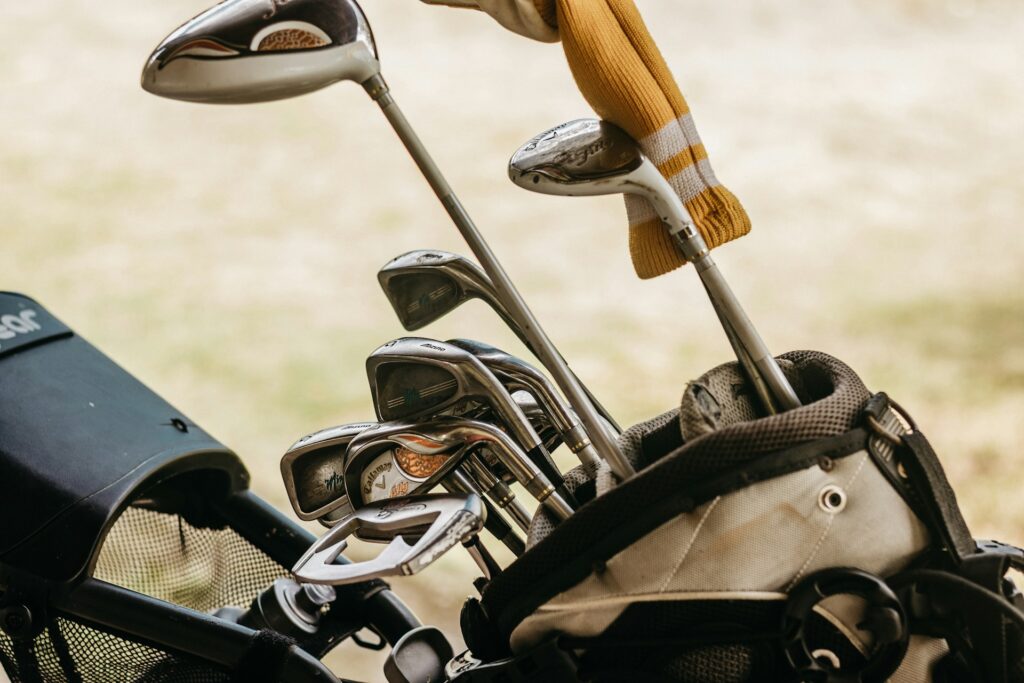Cheapest Way to Golf: Complete Beginner’s Guide (2025)
Key Takeaways: Cheapest Way to Golf
- Buy used golf clubs or budget brands online.
- Use recycled golf balls and basic accessories.
- Practice swings at home to save money.
- Play twilight rounds and short courses.
- Walk the course instead of renting a cart.
- Use discount golf apps for booking cheaper tee times.
This post contains affiliate links. If you purchase through these links, I may earn a small commission at no additional cost to you. Your support helps keep this site running—thank you!
Cheap Golf Clubs
How Beginners Save!
Most people getting into golf think they gotta spend loads of cash right away. Truth is, the cheapest way to golf starts with buying used clubs. A brand new set might cost you hundreds or even thousands, but second-hand clubs can cost way less.

Here’s the thing, you don’t even need a full set. Seriously, forget all those clubs you see pros hauling around. As a beginner, you’ll mostly just use these:
- Driver (the big one)
- Putter (the flat one for putting, duh)
- Irons (just 2 or 3)
Honestly, that’s plenty. You don’t need a fancy wedge or hybrid right now.
Best spots for cheap golf clubs:
| Store | Average Price for Beginner Sets |
| eBay | $75-$200 |
| Facebook Marketplace | $50-$150 |
| Rock Bottom Golf | $150-$300 (brand new, budget brands) |
Buying used is safe, just make sure the clubs don’t have any huge dents or rust. Scratches and wear are fine—they won’t ruin your game at all. Check the grips too; replacing grips is cheap if you need to.
And don’t get sucked into thinking name brands matter. Big brands like Callaway or TaylorMade sound nice, but honestly, cheaper brands or older models work exactly the same when you’re just learning. Save the fancy brands for later once you know you really enjoy playing.
Some common beginner questions on clubs:
- Do I need a full set right away?
Nope, it’s cheaper to get 4-5 clubs first, then add more later if you want. - How old is too old for used clubs?
Anything from the last 10-15 years works perfectly fine. Tech hasn’t changed enough to worry about it at your level. - Should I get fitted clubs as a beginner?
Not yet. Wait until you know your swing better.
So yeah, don’t blow your cash on clubs at first. Buying used and minimal is hands-down the cheapest way to golf, especially if you’re just testing the waters to see if golf’s your thing.
Cheapest Golf Balls
And Gear You Actually Use!
Golf balls disappear fast. They just do. You hit ’em into the woods, lakes, and even straight into the grass, never to be found again. So don’t spend much on balls, especially when starting out. The cheapest way to golf includes buying recycled or used balls. Brands like Titleist or Callaway make recycled ones, but any decent-quality used balls from Amazon or your local shop will work just fine.

Prices of Golf Balls (What You Should Expect to Pay):
| Ball Type | Cost per Dozen |
| New, premium brand | $45–$55 |
| Budget brand (new) | $15–$25 |
| Recycled / used balls | $5–$15 |
Recycled balls are pretty much balls other players lost after hitting bad shots. They’re cleaned up and sold cheap. Some might have logos or pen marks on them, but that’s no big deal—they fly exactly the same. Don’t let people convince you that cheap balls hurt your game. Trust me, as a beginner, you won’t notice the difference.
Other stuff you actually need:
- Golf Glove: Not fancy, just cheap and functional. It’ll stop your hands from blistering up. A glove usually costs around $10–$15 at discount stores.
- Shoes: You do NOT need golf shoes yet. Regular comfy sneakers are perfectly fine when you’re starting out.
- Tees: Wooden tees cost almost nothing. Get a pack of 50–100 for like 5-10 bucks.
- Valuables Pouch: Something small for your phone, keys, wallet. You probably already got something laying around at home.
- Divot Tool & Ball Marker: You’ll use it once you’re out there on real courses. They’re usually given out free at pro-shops or courses. But if not, it’s under $5.

Things You Don’t Need Yet (Save Your Money!):
- Golf-specific clothing (just wear comfy athletic gear)
- Expensive golf shoes
- GPS rangefinders (use free phone apps instead)
- Fancy golf bags (used bags online are plenty good)
A quick story: a friend of mine blew $200 on expensive golf balls when he first started. Guess what? He lost every single one within a few weeks. Complete waste of cash. Don’t be that guy or gal. Keep it cheap, simple, and replaceable.
Typical questions beginners ask about golf gear:
- Are cheap golf balls worse for beginners?
Nope, you honestly won’t tell any difference at all. Cheap balls fly straight and far enough for beginners. - Do recycled balls wear out faster?
Not enough for you to care. You’ll lose them long before you wear them out. - When should I invest in better gear?
Wait till you’ve played a few months and know you’ll stick with it. Then slowly upgrade.
Bottom line, cheapest golf gear doesn’t mean you’re sacrificing fun or learning. Save cash for playing rounds, not gear you don’t need yet.
Cheapest Way to Practice Golf
If you wanna get better at golf, you gotta practice. But paying every single time for a driving range or lessons adds up super quick. So what’s the cheapest way to golf and improve your swing at the same time? Practice at home—seriously. You don’t even need a huge backyard, just a little bit of open space.

Here’s what you do first:
- Grab a cheap practice mat (about $20–$30 online). If you’re super tight on cash, even carpet or grass works fine.
- Get some plastic or foam golf balls (around $10–$15). They won’t break stuff if you mess up your swing.
- Watch a bunch of free golf tutorials on YouTube. Channels like MeAndMyGolf or Rick Shiels Golf are solid and won’t cost you anything.
If you got no space at all, use a mirror. Practicing swings in front of a mirror lets you see exactly how your swing looks. It feels weird at first, and your family might laugh at you, but it honestly helps a ton. Plus, free.
When you feel ready, add in cheap trips to the driving range. Range buckets usually cost between $5 and $12. But there’s smart ways to save cash here too:
- Go during off-hours or “happy hours” when range buckets are cheaper.
- Split a large bucket with a friend. You both get practice, you both save cash.
- Find local courses that offer free putting greens or short-game practice areas.
Here’s a quick breakdown:
| Practice Type | Approximate Cost |
| Swing practice at home | Free–$30 (initial setup) |
| Driving range (small bucket) | $5–$8 |
| Driving range (large bucket) | $10–$15 |
| Short game & putting practice | Often free at municipal courses |
Also, focus way more on short game. I promise you’ll save yourself tons of frustration on the course. Putting and chipping make up more than half your shots in any given round. Spend more time there, and you’ll see real improvement without needing expensive lessons.
Common beginner questions about practicing cheap:
- Can I really improve practicing at home?
Definitely, especially if you focus on form and consistency. - How often should beginners practice?
A few short sessions per week at home and maybe 1-2 times at a range is plenty. - Are golf lessons necessary when starting out?
Nah, not yet. Get your basics down first for free, then maybe grab a cheap group lesson later on.
Quick personal tip here: don’t just mindlessly hit balls at the range. That’s a waste. Instead, pick specific targets, try different clubs, and think about each shot. Quality over quantity saves money and gets you better, faster.
Cheapest Golf Courses for Beginners (Where to Actually Play)
Now let’s talk about actually playing golf without emptying your wallet. Lots of new golfers make the mistake of booking rounds at fancy, pricey courses. Don’t do that. Seriously, just don’t. The cheapest way to golf is sticking with public and municipal courses, short courses, or playing during off-peak hours.

Here’s exactly how you save cash when choosing where to play:
1. Municipal Courses (Hidden Gems for Beginners)
Municipal courses are city-owned, usually cheap, and perfect for beginners. They’re more laid-back, you won’t feel judged, and they’re way cheaper than private or fancy public courses.
Some awesome examples you might find around the country:
| Municipal Course | Location | Typical Cost per Round |
| Bethpage Red | New York | $55–$100 |
| Buffalo Dunes | Kansas | $25–$30 |
| Rancho Park Golf Course | Los Angeles, CA | $25–$40 |
| Papago Golf Course | Phoenix, AZ | $30–$50 |
These prices are super reasonable. Plus, the vibe is chill, nobody cares if you’re slow or bad at first.
2. Twilight Golf (Cheaper Golf After Work)
Twilight golf is hands-down the best-kept secret for cheap golf. Courses offer lower rates later in the day—usually after 3 PM or so. You pay about 15–30% less, sometimes even cheaper. The course might be a little busier, and you might not finish all 18 holes, but it’s perfect for practice without blowing your cash.
Average Twilight Rates:
| Course Type | Regular Rate | Twilight Rate |
| High-end public | $75–$120 | $40–$65 |
| Municipal/public | $30–$50 | $15–$30 |
Honestly, twilight rounds are the sweet spot. The sun’s setting, it’s chill out there, and you’ll save a nice chunk of money every single round.
3. Short Courses and Par-3s (Great for Quick, Cheap Golf)
Short courses, or par-3 courses, are perfect for beginners. They’re short (obviously), cheap, and easier to play. Usually you’ll pay between $10–$25 for a round. The holes are shorter, and you’ll use mostly your irons and putter, which means your short game improves quicker. Win-win.
Quick benefits:
- Shorter rounds (1–2 hours instead of 4–5)
- Way cheaper than full-sized courses
- Perfect place to practice the basics without pressure
Some questions beginners ask about affordable golf courses:
- Are municipal courses good quality?
Yep. They’re well-maintained, just without all the fancy extras. - Do I need to book twilight rounds early?
It’s a good idea. They’re popular because they’re cheap. - How long does it take to play a short course?
Usually less than two hours. Quick and easy practice.
Last thought—play cheap courses more often instead of expensive ones. You’ll get way better faster, enjoy the game more, and spend less money doing it.
Smart Tips for Playing Cheap Golf Regularly
Playing golf often doesn’t mean going broke. A lotta beginners think golf is pricey, and sure—it can be—but it doesn’t have to be. You just gotta be smart about it. Here’s some simple tricks that keep the costs down, so you can hit the course regularly without draining your cash.
Walk, Don’t Ride (It’s Healthier and Cheaper)
Riding in golf carts is easy, I know, but walking saves you money every round. A golf cart usually adds about $15–$25 each time you play. That adds up way faster than you think. Walking the course is free exercise too, so you’ll get fitter without even trying. Plus, you see the course better, learn distances, and have more time between shots to chill out.

Quick comparison:
| Play Method | Cost per Round |
| Cart rental | $15–$25 |
| Walking | Free |
Ain’t even a question here. Walking is clearly the cheapest way to golf regularly.
Discount Apps (Save Money With Your Phone)
There’s loads of apps that give discounted tee times at golf courses nearby. GolfNow, TeeOff, or Supreme Golf are popular ones. You book tee times at odd hours (like midday weekdays or twilight), and they give you deals. Usually, you save 15–50% off regular prices.
Easy apps that beginners should grab:
- GolfNow: Tons of local deals, daily discounts
- TeeOff: Same idea, different courses
- Supreme Golf: Compares deals from different apps to find the absolute lowest price
Downloading these is a no-brainer if you wanna play cheap golf. Check them often, grab deals quick, and you’ll save cash every single round.
Military, Student, or Senior Discounts (Don’t Forget to Ask)
This one’s obvious, but people always forget to check. If you’re military, a student, or over 60—ask for discounts. Golf courses won’t advertise these loudly, but they often have them. Usually saves you around 10–20% per round. Every little bit counts, right?
Quick table on typical discounts:
| Discount Type | Typical Savings |
| Military Discount | 10–25% |
| Student Discount | 10–15% |
| Senior Discount | 10–20% |
Even if you’re unsure, always ask. Worst case, they say no. Best case, you just saved yourself money.
Unlimited Play Passes (Only if You Play Often)
This one’s tricky. Unlimited golf passes can save you a ton if you actually play a lot. But they cost more upfront. For example, some municipal courses offer unlimited play passes for around $1,500–$2,500 per year.
Here’s the breakdown to see if it makes sense:
- Say a round typically costs you $35.
- If you play once per week, that’s around 52 rounds a year (52 x $35 = $1,820).
- If an unlimited pass costs $1,500, you’ll break even after about 43 rounds.
If you know you’ll play regularly (weekly or more), these passes are super worth it. If you’re not sure yet, skip it and stick to paying round-by-round for now.
Common questions beginners ask about playing golf cheaply:
- Do golf courses care if you walk instead of ride?
Nope, they usually encourage it. Just play fast enough to keep pace. - Are golf discount apps reliable?
Very reliable, just read user reviews first. - How often should I play before getting an unlimited pass?
Play weekly or more—otherwise, pay individually.
Keep golf cheap by playing smart. Walk the course, use discount apps, ask for deals, and only invest in passes when it really makes sense. Your wallet will thank you later.
Avoiding Common Beginner Mistakes (That Cost You Money)
When you’re trying out golf for the first time, you’ll probably make mistakes. We all do. But some beginner slip-ups cost way more money than they should. So, the cheapest way to golf includes avoiding these common and pricey beginner mistakes. Let’s run through ’em quick so you don’t blow your budget early on.
Mistake 1: Buying Expensive Gear Right Away

You’ve heard it before, but I’ll say it again—don’t go fancy at first. Many newbies buy expensive clubs thinking they’ll instantly play better. You won’t. Trust me. Golf’s tricky, expensive clubs don’t magically make you good. Start with cheap, used, or budget brands. Later, upgrade once you know your swing, what clubs you like, and when you’ve got the cash.
Real talk, golf clubs made within the last decade all do basically the same thing at the beginner level. A $50 used driver from Facebook hits almost exactly the same as a $500 one for a beginner.
Mistake 2: Ignoring Cheap Practice Opportunities
Beginners waste so much money hitting balls aimlessly at driving ranges. Sure, the range helps, but you gotta practice smart, not just blast away buckets and buckets of balls.
Better options:
- Spend more time on short-game areas (often free at municipal courses).
- Practice at home more often (it’s free).
- Use YouTube lessons to learn swing basics before hitting balls.
Practice smarter, not harder, and you’ll actually improve faster while spending less.
Mistake 3: Choosing the Wrong Courses

Some beginners jump straight into expensive courses thinking they’ll learn faster. Big mistake. You’ll lose tons of balls, annoy other players, and feel rushed. Not fun, and definitely not cheap.
Stick with cheap courses at first, or at least twilight rounds. They’re beginner-friendly and won’t empty your pockets. Par-3 and short courses especially—these are gold for new players.
Here’s a quick table to compare typical beginner course costs:
| Course Type | Average Cost per Round |
| High-end public | $80–$150 |
| Regular public | $40–$70 |
| Municipal or short course | $15–$35 |
The math ain’t hard. Go cheap.
Mistake 4: Not Planning Ahead for Tee Times
If you just walk up and pay at a course, you’re probably paying way more than you need to. Booking online or through apps almost always costs less—especially through discount apps like GolfNow or TeeOff.
Don’t pay full price unless you have to. Planning a day ahead can save you 20–40% each time.
Mistake 5: Riding a Cart Too Often
Cart fees pile up fast. Beginners think carts are mandatory—nope, they’re optional nearly everywhere. Just walk. It saves you money and gets you healthy. Double win.
Common beginner questions about avoiding these mistakes:
- Will cheap gear really affect my learning?
Nope. Technique matters way more than fancy clubs. - Are expensive courses ever worth it for beginners?
Not yet. Start cheap, then level up as your skills improve. - Is booking online really cheaper?
Almost always. Courses want guaranteed bookings, so they discount those spots.
Golf’s fun, but it ain’t cheap unless you do it right. Avoid these common money-wasting mistakes, and you’ll have more fun and more rounds on your budget.
How Beginners Can Improve Fast Without Spending Big
You wanna get better quick, but golf lessons and expensive coaching aren’t exactly budget-friendly. Good news—improving quickly doesn’t have to mean spending big. You just need a simple game plan. The cheapest way to golf includes learning smart, and you can easily do this at home and on budget-friendly courses.
Here’s exactly how you level up fast without overspending:
Master the Basics at Home First

Most beginners rush to the course or driving range way too soon. Slow down. Get your fundamentals solid first. Spend time at home watching instructional videos (Rick Shiels Golf, Danny Maude, or MeAndMyGolf).
Three main things to focus on first:
- Grip: Hold the club naturally, not too tight. Lots of beginners squeeze too hard.
- Posture: Bend slightly at your hips, knees flexed. Keep your spine fairly straight.
- Basic Swing Mechanics: Smooth, relaxed swings work better than swinging super hard.
Practice these at home for a week or two before spending money at ranges. Sounds boring, I get it, but it’ll seriously help your swing—and save cash.
Short Game is King (Cheap and Easy to Improve)
Putting and chipping are the easiest (and cheapest) ways to cut strokes. Beginners spend way too much time smacking drives instead of short game practice.
Quick practice ideas:
- Carpet Putting: Just roll putts on your carpet towards a cup or target. It builds confidence and touch without paying anything.
- Backyard Chipping: Grab foam or plastic balls, chip around your yard. Even a small space works. It’s free, fun, and improves your scores faster than anything else.
Check out this quick comparison:
| Practice Type | Cost | Skill Impact |
| Driving range (driver/irons) | $8–$12 per session | Moderate |
| Putting/short game at home | Free | Huge improvement |
Invest your time smartly. It pays off way more in scoring.
Play from Forward Tees
Beginners often pick tees way too far back. They wanna play from the same tees as experienced players. Don’t. It slows you down, frustrates you, and costs you extra golf balls.
Pick forward tees (red or gold usually). You’ll shoot lower scores, lose fewer balls, and enjoy the game more. Plus, it speeds things up so you can play twilight rounds more easily.
Film Your Swing with Your Phone (Seriously, Do This)
Recording your swing costs exactly zero dollars. Just set your phone down behind you or ask a friend to film. Seeing your swing helps you understand what’s working or not. It’s the cheapest way ever to improve your technique without lessons.
Watch your swing in slow-mo, compare it to YouTube swing tutorials, and you’ll quickly notice where you’re messing up. Easy fix, huge payoff.
Common beginner questions about fast improvement without overspending:
- Should beginners take paid lessons at first?
Wait till you have basic swing skills. Then try cheap group lessons. - Can short game practice at home really help my scores?
Yep. Most strokes are around the green. Improve there, and your scores drop quick. - Are forward tees too easy for beginners?
No way. Golf’s hard enough. Make it easier on yourself until you’re better.
Golf improvement doesn’t equal expensive lessons and endless range sessions. Master the basics at home, practice your short game more, pick the right tees, and film your swing. Do this consistently, and you’ll improve faster than you’d believe—without overspending.
Cheapest Way to Golf Regularly: Affordable Memberships and Passes
Golf memberships probably make you think of rich country clubs, fancy locker rooms, and pricey initiation fees. But guess what? There’s actually affordable memberships and season passes for normal people like us, too. And if you plan to golf more than a few times a month, these cheap golf passes can save you tons of cash. Seriously.
Let me explain quick. A typical round at your local course might cost between $30–$50 each time. Play once a week, and that quickly adds up:
- 1 round/week at $35 each = $1,820 a year
- Unlimited membership at municipal courses: Usually around $1,000–$2,500 per year
- Break-even point: about 30–50 rounds
So if you think you’ll golf once a week or more, memberships start to look real good. They pay off fast.
Here’s a quick table showing how quickly you break even:
| Annual Membership Cost | Break-Even Point (# of rounds @ $35 each) |
| $1,000 | ~29 rounds |
| $1,500 | ~43 rounds |
| $2,500 | ~72 rounds (good if you play a ton) |
Quick tip: municipal or public course passes are cheapest. They’re basic, no frills, and made exactly for players looking for value.
How to Find the Cheapest Memberships:
- Check municipal courses first. City-run places often have hidden affordable membership options.
- Call smaller local courses directly. Sometimes they have yearly passes that aren’t widely advertised.
- Ask about “weekday only” memberships. They’re cheaper and still let you play plenty.
- Look out for courses offering monthly payment options. Splitting the cost over 12 months is easier on your wallet.
Golf Discount Cards (The Middle Ground)
Not ready for a full membership? Grab a golf discount card instead. Courses sell these cards for around $50–$150 per year. Then you get discounts every time you play, usually 15–40% off per round. If you’re not sure you’ll play enough for a full membership, these are perfect.
Example of how discount cards help you save:
- Regular round cost: $40
- Discount with card: $25
- Savings per round: $15
- If the card costs $100, you’d save cash after playing just 4–5 rounds.
Course Multi-Packs (Save With Bulk Buys)
Many courses also sell multi-round packs—like a 10-round pack—for cheaper rates than buying each round separately. These packs save you around 10–25% per round.
Here’s how it looks:
| Regular Rate (1 round) | Multi-Pack Rate (10 rounds) | Savings |
| $40 | $300 ($30 per round) | $100 (25% off) |
Quick beginner FAQ on golf memberships:
- Do you get worse tee times with cheap memberships?
Nope. Usually first-come, first-serve like everyone else. - Are discount cards limited to certain courses?
Usually yes, so pick courses you actually like playing. - Can I share multi-packs with friends?
Some courses allow it. Just ask first.
Bottom line here: Memberships or discount cards aren’t just for rich golfers. They’re actually the smartest, cheapest way to golf regularly if you’re gonna play often.
Frequently Asked Questions: Cheapest Way to Golf (Beginner’s Edition)
New golfers have questions—a ton of them, actually. So let’s finish up by quickly answering the stuff beginners ask the most about finding the cheapest way to golf. I kept the answers real short and practical, no fluff.
Q1: How much should beginners really spend on golf clubs?
Answer: Under $200 total. Honestly, $100–$150 is plenty for a decent used set with a few basic clubs like a driver, putter, and irons. You won’t need anything fancy yet.
Q2: Are recycled or cheap golf balls any good?
Answer: Yeah, totally fine. You’ll barely notice any difference when starting out. Cheap or recycled balls fly almost exactly the same as pricey ones. Save your money.
Q3: Is walking the course really worth the savings?
Answer: Absolutely. Walking saves $15–$25 per round. Over 10 rounds, that’s easily $150–$250 saved. Plus, you get exercise. Win-win.
Q4: Should beginners buy golf shoes right away?
Answer: Nope. Regular tennis shoes or sneakers work just fine at first. Don’t spend extra cash on golf shoes until you’re serious and play regularly.
Q5: Do I need golf lessons as a beginner?
Answer: Not immediately. Free online videos on YouTube and basic home practice work great at first. After a month or two, consider a cheap group lesson if you still want help.
Q6: Can I practice golf effectively at home?
Answer: Definitely. Use a cheap practice mat ($20–$30) or even your carpet. Foam balls indoors or plastic balls outdoors are perfect. It costs next to nothing and really helps your swing.
Q7: What’s the best way to find cheap tee times?
Answer: GolfNow, TeeOff, and Supreme Golf apps are best. Book at off-peak times like twilight or weekdays. You’ll usually save around 25–50% per round.
Q8: Is it okay to start golfing at cheap municipal courses?
Answer: 100% yes. Municipal courses are perfect for beginners—cheap, relaxed, and welcoming. It’s where nearly all new golfers start anyway.
Q9: When should beginners consider golf memberships?
Answer: When you play more than once a week consistently. If you’re only playing occasionally, stick to cheap daily fees or multi-packs instead.
Q10: Are short or par-3 courses good for beginners?
Answer: They’re perfect. Short courses are cheap ($10–$25), easy, quick to play, and help beginners build skills fast. Highly recommend.
Follow these tips, stay smart about your spending, and you’ll enjoy golf without breaking the bank. Happy golfing!


